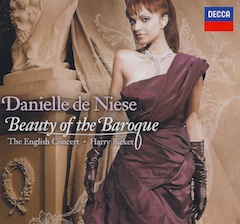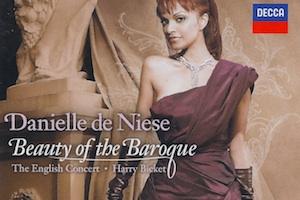
Suffused with more personality and verve than five other Baroque recitals combined, Danielle de Niese’s Beauty of the Baroque comes as a revelation — not so much for its pyrotechnics, but rather for the way in which the soprano newly illumines familiar as well as less-known Baroque classics.
No better examples can be found than in Dowland’s Come Again: Sweet Love Doth Now Invite and What if I Never Speed? How many white-voiced English sopranos have we heard adopt a uniformly plaintive tone as they sweetly sigh their way through the former, to unadorned lute accompaniment?
Forget all that. To the marvelously colored period-instrument sounds of The English Concert under Harry Bicket, de Niese puts the Baroque equivalent of a jazz singer’s smile on her voice. No, she doesn’t croon or swoop à la Renée, scat like Ella, or in any way deviate from what we currently consider authentic Baroque style. But she does bless these songs with an uncommon air of youthful expectation that lays their conceits wide open.
Listen To The Music
John Dowland: "Come again sweet love doth now invite"Monteverdi: "Pur ti miro"


Related Article
Download Free Danielle de Niese MP3: Ombra Mai Fù
In de Niese’s throat and breast, Dowland’s young loves are almost panting with excitement. When, in Come Again, Sweet Love, she sings “by sighs and tears more hot than are thy shafts,” we know that the “wounding dart” of gentle love may have more than metaphoric consequences.
A similarly refreshing approach comes in Handel’s “Let the Bright Seraphim” (from Samson). Unable to produce Joan Sutherland’s dazzling high notes, but nonetheless blessed with a good trill and coloratura facility, de Niese gives us such ear-opening variations in the recapitulation as to make the aria sound new. Unless you’ve spent the entire aria waiting for the big “pop,” you end feeling sated rather than cheated.
In her three duets with the marvelous Andreas Scholl, de Niese’s effusive personality provides a wonderful contrast to the countertenor’s simpler, purer expression. She certainly comes off as the more eager and breathless of the pair in Monteverdi’s “Pur ti miro” (from L’incoronazione di Poppea). This performance is as distinguished by The English Concert’s gorgeous sounds as it is by the lovely blend of these two contrasting artists’ voices and energies.
Given that grief is not her strong suit, the soprano’s rendition of Purcell’s iconic “When I Am Laid in Earth” from Dido and Aeneas is unlikely to supplant graver and more-chaste renditions by Susan Graham, Lorraine Hunt Lieberson, Janet Baker, and many others. Nor does her fine “Sich üben im Lieben,” the irresistibly tuneful and eminently whistleable aria from Bach’s Wedding Cantata, have quite the innocent sparkle of some other versions.
Yet de Niese is anything but a “one-voice” singer. For Bach’s beloved Sheep May Safely Graze, she opens the middle of her tone while covering the top, to produce a performance of heartfelt depth and grace. It is at moments like this — and there are many on this unfailingly lovely CD — that you realize that the all-singing, all-dancing beauty is a formidable artist.

